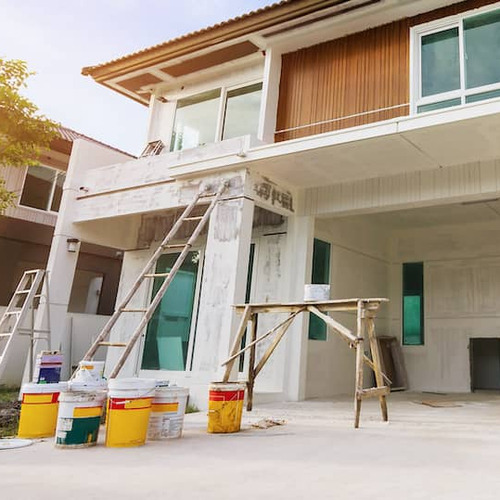Capital improvements: When are your home renovations tax-deductible?
Jul 25, 2025
•9-minute read

If you’re thinking about making home improvements and wondering how they might increase your home's value, you’ll want to learn more about capital improvements. These are home renovations that increase your home’s value and also may be tax-deductible.
What are capital improvements?
A capital improvement is a substantial and permanent alteration or repair to your home that increases your overall home value. Capital improvements typically include projects that modernize your property, extend its life, or adapt it to new needs, such as making the house accessible for medical purposes. They also can include significant additions like a new room or more minor upgrades, such as installing energy-efficient appliances. However, simple updates, basic maintenance, and repairs aren’t considered capital improvements.
“Unlike routine repairs, capital improvements typically become part of the property itself,” says Paul Miller, a certified public accountant and managing partner of Miller & Co. in New York City.
Documenting capital improvements, such as a renovation or remodel, can reduce your tax liability. Capital improvements typically are exempt from sales taxes and can help you pay less capital gains tax when you sell your property.
“I oversaw the makeover of a 100-year-old townhouse I was renting in Brooklyn,” says Dennis Shirshikov, a professor of finance and economics at City University of New York. “It involved many capital improvements, including re-plumbing an old, galvanized pipe system, which wiped out decades of rotten internal waterworks and sent the value of the house skyrocketing.”
How does cost basis relate to capital improvements?
Cost basis is the original cost of a property adjusted for factors such as improvements and depreciation. It typically includes the purchase price of your property plus closing costs and the cost of eligible home improvements.
“Think of cost basis as the starting point for figuring out your taxable gain when you plan to sell your home,” Miller says.
When you sell your home, you subtract the cost basis from the sale price to calculate your profit, which may be taxable. Capital improvements increase your cost basis, which can reduce how much of your profit is taxable when you sell your home.
For your improvements to qualify, it’s important to follow IRS rules. Typically, you must ensure the improvement:
- Is a permanent fixture of the home
- Is a desirable feature
- Increases the home’s value.
More minor repairs and updates that aren’t permanent, such as adding or removing carpeting, generally don’t qualify as capital improvements. However, the repair or improvement could be eligible if it is part of a larger project. For example, painting a home’s interior itself is not a capital improvement, but repainting after a fire as part of the repair might be.
Other times when a repair might not qualify as a capital home improvement include:
- It has a useful life of less than a year
- It’s maintenance that doesn’t improve your home’s value
- It’s a repair or improvement that has been undone, such as wall-to-wall carpet that was installed when you bought the home and later removed.
The IRS’s 523 publication lists accepted capital improvements.
Capital improvements that increase cost basis
Renovations or repairs that increase the cost basis of your home may qualify as capital improvements. Examples include installing central air conditioning or making energy-efficient home improvements. Building a permanent home addition, such as an enclosed garage or a screened-in front porch, also may qualify as a capital improvement.
Here are some examples of capital improvements that can increase your cost basis:
- Additions. Bedroom, bathroom, deck, garage, porch, patio
- Lawn and grounds. Landscaping, driveway, walkway, fence, retaining wall, swimming pool
- Systems. Furnace, central air conditioning, ductwork, central humidifier, central vacuum, air and water filtration systems, wiring, security system, lawn sprinkler system
- Exterior projects. Storm windows and doors, new roof, new siding, satellite dish
- Insulation. Attic, walls, floors, pipes, and ductwork
- Plumbing. Septic system, water heater, soft water system, filtration system
- Interior projects. Built-in appliances, kitchen modernization, flooring, wall-to-wall carpeting, fireplace
“Some improvements blur the lines between repairs and capital upgrades,” Miller says. “For example, a repair that goes beyond restoration, such as replacing an entire HVAC system, can be considered a capital improvement.”
Shirshikov gives another “blurry” example: “Typical landscaping work is not considered a capital improvement. But if you are installing an irrigation system that changes the drainage of your property and prevents erosion, it may be eligible as a capital improvement.”
Capital improvements for medical purposes
Do you have a family member with a health condition or disability that requires making your home more accessible? Fortunately, there’s another type of capital improvement that can be considered for a tax deduction: a renovation or addition made for medical purposes. You can upgrade or renovate aspects of the house to support the medical welfare of you, your spouse, or your dependents.
The IRS defines medical expenses as what you pay for diagnosing, treating, preventing, or managing a disease or condition that affects your body or mind. Fees for physicians, dentists, surgeons, and other health care professionals, as well as the cost of medical equipment, supplies, and tests needed for care, are all eligible. Medical expenses also cover health insurance premiums, transportation for medical care, certain long-term care services, and some long-term care insurance costs. However, here’s the catch: To qualify, the expense must be primarily for the treatment or prevention of a physical or mental illness. Expenses that improve general well-being, like traveling to a healing retreat or buying vitamins, are ineligible.
Any permanent home improvements in this category can be included as medical expenses, which are exempt from taxes. Some examples of home renovations made for medical purposes include:
- Adding railings, grab bars, or other bathroom safety features
- Upgrading fire alarms, smoke detectors, and warning systems
- Lowering or changing kitchen cabinets and appliances for easier access
- Reshaping the ground outside to improve access to the home
- Widening doorways at home entrances or exits
- Installing porch lifts or similar devices
- Modifying entryway areas for better access
- Adding handrails or grab bars in any location
- Relocating or adjusting electrical outlets and light fixtures
- Expanding or adjusting hallways and interior doorways
- Building entrance or exit ramps at your home
- Altering stairways for easier or safer use
- Changing door handles, locks, or other door hardware
“I once helped a family install a gently sloping ramp and bathroom grab bars for an aging parent,” says Jacob Naig, a real estate agent, investor, and property manager in Des Moines, Iowa. “Although the out-of-pocket expense was not added to their cost basis, they could claim it on Schedule A of their tax return, which reduced their overall tax liability.”
What is the capital gains tax exemption?
Capital gains taxes apply to profits you earn from selling assets, such as stocks, bonds, and real estate. Different tax rates apply to gains from assets held for less than a year and those held for more than a year.
When it comes to a home sale, the capital gains tax typically applies if you sell it for more than its original purchase price. If you bought a home for $200,000 and sold it for $300,000, the capital gain is $100,000 and is subject to the capital gains tax.
The IRS offers an exemption from the capital gains tax when selling your primary residence. To qualify for the tax exemption, you must have owned and used your home as your primary residence for at least two out of the past five years. If you’re a single taxpayer, the first $250,000 of profit from selling your primary residence is exempt from capital gains tax. If you’re married and filing jointly, the first $500,000 of profit from selling your primary residence is exempt.
The amount you pay capital gains tax on depends on your cost basis. The taxable amount is calculated by subtracting your cost basis from the sale price. The higher your cost basis, the less you pay in capital gains taxes.
For example, say you buy a home for $300,000. Over the years you own it, you spend $50,000 on eligible capital improvements such as a kitchen remodel and a new furnace. When you decide to sell, your cost basis would be $350,000. If you sell your home for $750,000, your capital gain would be $400,000. You file as a single taxpayer, so the first $250,000 is exempt, and you’d pay capital gains tax on $150,000. Without those improvements, your capital gain would be $450,000 and you’d have to pay capital gains tax on $200,000. Assuming a 15% capital gains tax rate, claiming capital improvements will reduce your tax bill from $30,000 to $22,500.
How do homeowners finance capital improvements?
There are several ways homeowners pay for ß.
Cash-out refinance
A cash-out refinance is when a homeowner takes out a new mortgage based on their home’s current market value, pays off the balance on their original loan, and keeps the difference in cash. The homeowner repays the cash as part of their new mortgage payment. A cash-out refinance requires you to have sufficient home equity to borrow. It also allows you to change your loan type and loan term.
Home equity loan
A home equity loan is a second mortgage where you borrow some of your home equity as a lump sum. You repay the loan in fixed monthly installments over an agreed period in addition to your primary mortgage. Home equity loans typically have fixed interest rates, which means your rate won’t change for the life of the loan. You can choose from several different loan terms, typically ranging from 10 to 30 years. The shorter your term, the larger your monthly payment.
Home equity line of credit (HELOC)
A home equity line of credit, or HELOC, is a second mortgage where your home equity is used to create a line of credit that you can use as needed.
A HELOC begins with a draw period, when you can borrow from your credit line as needed and make either minimum or interest-only payments on what you use. Once the draw period ends, your repayment period begins, and you can no longer borrow funds. You’ll make full monthly payments covering both principal and interest until the loan is paid off.
The length of these periods is based on your HELOC’s terms. For instance, a 30-year HELOC might offer a 10-year draw period followed by a 20-year repayment phase. A longer repayment period means smaller monthly payments but more interest over time, while a shorter one means higher payments with less interest in the long run.
Rocket Mortgage® does not offer HELOCs at this time.
FAQ
Here are answers to common questions about capital improvements.
What is the difference between maintenance and capital improvements?
Maintenance tasks like cleaning your gutters, power-washing your driveway, and trimming your shrubs and trees keep your home in good condition, but do not materially add value or prolong its life the way that fixing a leaky faucet or patching the roof would. Capital improvements go a step further than maintenance: They make your property better than it was before, or they extend its useful life significantly.
Are there exceptions to deductible capital improvements?
Yes. Some capital improvements could be partially deductible or non-deductible depending on their purpose. For example, improvements with personal components, such as adding a swimming pool, are usually not deductible as medical expenses, although you can still add them to your cost basis. Specific energy-efficient improvements qualify for tax credits, not tax deductions. Also, you usually cannot depreciate capital improvements in the same year in which you make these improvements.
What is a capital improvement fee?
When you sell a home that’s part of a homeowners association, the HOA may charge a one-time capital improvement fee. Typically, a small percentage of the sales price or a specific dollar amount, this fee helps pay for major upgrades, replacements, and capital improvements within the community. A capital improvement fee is different from a routine maintenance fee.
What is a capital improvement plan?
A capital improvement plan is usually a multiyear plan to fund and execute capital improvements in a city or community. Municipalities, associations, and large property owners use these plans to budget for significant upgrades. Also called a capital improvement program, a capital project uses non-recurring capital expenditures to construct, develop, or make upgrades to public buildings, bridges, parks, and transportation features. These features may include roads, sidewalks, bike lanes, bus stops, and subway platforms.
What is a certificate of capital improvement?
A certificate of capital improvement is a document that a property owner or other customer gives to a contractor or project manager. This document certifies that the project qualifies as a capital improvement and that no sales tax should be collected.
The bottom line: Capital improvements help your home and reduce your taxes
Capital improvements are permanent upgrades or structural changes to your residence that enhance its value, extend its useful life, or adapt it to new needs. These updates can increase your property’s cost basis, which decreases your taxable profit when you sell the home. That can reduce what you owe in capital gains tax. In some cases, specific improvements – particularly those made for energy efficiency or medical reasons – could also yield extra tax deductions or credits while you still own the home.
Although capital improvements have parameters, there are several ways to implement them and benefit from tax-exempt opportunities. If you’re thinking about listing your home for sale, speak with a tax advisor.
One way to finance a capital improvement project is by borrowing your home’s equity with a cash-out refinance. Start a mortgage application to see how much you qualify for.
Erik J Martin
Erik J. Martin is a Chicagoland-based freelance writer whose articles have been published by US News & World Report, Bankrate, Forbes Advisor, The Motley Fool, AARP The Magazine, USAA, Chicago Tribune, Reader's Digest, and other publications. He writes regularly about personal finance, loans, insurance, home improvement, technology, health care, and entertainment for a variety of clients. His career as a professional writer, editor and blogger spans over 32 years, during which time he's crafted thousands of stories. Erik also hosts a podcast (Cineversary.com) and publishes several blogs, including martinspiration.com and cineversegroup.com.
Related resources
7-minute read
A guide for understanding home improvement loans
Home improvement loans can help you finance anything from a few cosmetic changes to a major renovation. Figure out what loan option is right for you.
Read more
6-minute read
Renovation and remodeling: The differences explained
The key differences between renovation and remodeling are the time, cost and type of home alterations involved. See what those differences mean for your budg...
Read more

10-minute read
Home improvement grants to fund your next repair project
Home improvement grants are a type of financial aid for homeowners to make necessary repairs to their home. Check out our guide to find grant resources.
Read more